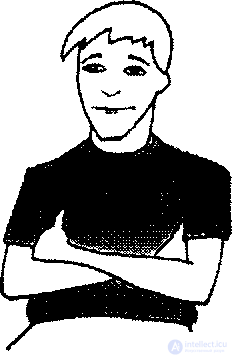Status can have a major impact on hand gestures. The dominant person demonstrates his superiority without crossing his arms. Thus, he as if says: “I am not afraid of anything. My body is open and vulnerable. ” Suppose that at a corporate party the general manager is represented by several new employees. He greets them with a handshake, palm down, rises at a considerable distance (not less than a meter) and lays his hands behind his back with a favorite gesture of Prince Philip "brush to hand". This position immediately demonstrates superiority. In addition, a manager may put one or both hands in his pockets, showing his disinterest. In such a situation, the manager is unlikely to fold his arms over his chest, not wanting to show even the weakest signs of nervousness.
Employees after a handshake with a boss can fully or partially cross their arms, since the presence of management always makes subordinates nervous. Both the leader and subordinates in such positions feel quite comfortable, since the chains of gestures correspond to their status relative to each other. But what happens if the general manager meets a young, energetic man who is prone to domination and is able to send a signal that he is no less important than his boss? Most likely, after a mutual dominant handshake, the young employee will cross his arms so that his thumbs are directed upwards.

Thumbs up: a defensive posture, but at the same time a person still seeks to emphasize his independence Arms crossed and upward thumbs indicate that a person considers himself independent and able to control the situation. At the time of the conversation, the movement of the thumbs emphasizes the meaning of what has been said. As we will see later on, thumbs pointing up are a way to demonstrate self-confidence to others, and crossed arms make you feel safe.
A person seeking to take a defensive position and at the same time feeling like a subordinate will take a symmetrical posture, that is, one side of his body will mirror the other side. The muscles of this person will be tense as he is constantly awaiting attack. If the defensive posture is occupied by the dominant person, it will be asymmetric, that is, the sides of the body will not be a mirror image of each other.
Thumbs up
If you present your product or idea to another person and at the end of the presentation you notice that the interlocutor crossed his arms over his chest, sending his thumbs up, and this signal is supported by other positive gestures, you can safely express your suggestion. On the other hand, if the interlocutor crossed his arms over his chest, clenched his fists, and his face does not express anything, you are unlikely to achieve the desired result. In such a situation, it is better to ask a few questions to try to identify the objections of the interlocutor. When a person responds to a proposal with a decisive refusal, it is very difficult to change his point of view without appearing aggressive. The ability to understand body language signals will allow you to notice signs of a negative decision before it is announced. Thanks to this, you get extra time to change the course of action.
|
Having noticed that the interlocutor intends to reject your offer, do not wait for the refusal. Try a different tactic.
| |
Armed people rarely cross their arms over their chest, as the weapon protects them quite effectively. Policemen, for example, almost never resort to such a gesture, unless they are on duty. As a rule, at such moments, they clench their fists, showing with their whole appearance that no one can slip past them.

Comments
To leave a comment
Body language
Terms: Body language